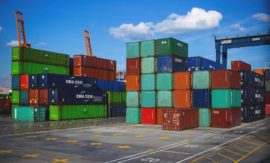Intended learning outcomes: Produce an overview on the product life cycle.
Products are made by converting goods. The use or utilization of products leads to their consumption or usage.
Consumption of goods (by the consumer) means, according to [MeWe18] the act of consuming or using up, and also, according to [Long15], the amount of goods that are used (up).
Goods that are used up must be disposed of properly. There is thus a life cycle to products.
Put simply, the product life cycle consists of three stages: design and manufacturing, use (and ultimately consumption), and disposal, which can be connected with recycling. [note 101].
Figure 1.1.5.1 shows the product life cycle. Design, manufacturing, service, and disposal are seen as value-adding processes,[note 102] symbolized by an arrow pointing in the direction of value-adding. Use is itself a process; however, it is a value-consuming one.
Fig. 1.1.5.1 The product life cycle.
The life cycle of material products generally begins with nature and leads from design and manufacturing to the consumer. A consumed product must then be disposed of, if ever possible connected with recycling of components and raw materials (circular economy, see Section 1.1.8). For materials that can not be reused, the product life cycle ends once again with nature, in that the materials are returned to the earth.
The life cycle of nonmaterial products begins with an issue about which something is declared. This issue, in a broad sense, can also be seen as ultimately connected to things in nature, whether to objects or at least to human thinking about objects. Disposal ends with the information being erased or deleted. In the broadest sense, then, it is also returned to nature.
Continuation in next subsection (1.1.5b)
Quiz on Chapter 1.1.1/1.1.5.: Goods, Products and the Product Life Cycle
Course section 1.1: Subsections and their intended learning outcomes

1.1 Basic Definitions, Issues, and Challenges
Intended learning outcomes: Produce an overview on terms of the working environment and of business life. Explain service orientation in the classical industry, product orientation in the service industry, and the industrial product-service system. Disclose the product life cycle, the synchronization of supply and demand, and the role of inventories. Produce an overview on supply chain management, the role of planning and control as well as the SCOR model.

1.1.1 Work, Task, Process, Method, Object, etc. — Important Terms of the Working Environment
Intended learning outcomes: Produce an overview on terms of the working environment, such as work, task, function, order, procedure, process, method, object, business.

1.1.1b Value-Added, Business Process, Material, Product, etc. — Important Terms of Business Life
Intended learning outcomes: Produce an overview on terms of business life, such as value-added, business process, business method, business object, goods, item, part, component, material, product, artifact, management, etc.

1.1.2 Service and Servitization — Service Orientation in the Classical Industry
Intended learning outcomes: Present terms of the service domain such as service, customer service, service in the originary sense, servitization. Differentiate between a (primary, or core) product, a product in a broad sense, and a product in the most comprehensive sense.

1.1.3 The Service Industry and Industrialization of Service — Product Orientation in the Service Industry
Intended learning outcomes: Differentiate between service industry and classical (or conventional) industry. Produce an overview on industrialization of service.

1.1.4 The Industrial Product-Service System IPSS (or IPS2)
Intended learning outcomes: Present the industrial product-service system. Explain product-oriented, use-oriented, and result-oriented services as well as their degree of intangibility.

1.1.5 The Product Life Cycle: Design and Manufacturing, Service and Use, Recycling and Disposal
Intended learning outcomes: Differentiate between terms such as logistics, operations, logistic management, operations management, and value-added management.

1.1.5b Logistics, Operations, Logistics Management, Operations Management, and Value-Added Management
Intended learning outcomes: Differentiate between terms such as logistics, operations, logistic management, operations management, and value-added management.

1.1.6 The Customer Tolerance Time (or Demand Lead Time), and the Role of Inventories
Intended learning outcomes: Describe supply, demand, lead time, and customer tolerance time. Explain the problem of temporal synchronization between supply and demand as well as the role of various kinds of inventories in solving this problem.

1.1.7 Supply Chain, Extended Enterprise, and Supply Chain Management
Intended learning outcomes: Describe the reasons for logistics networks, production networks, procurement networks, distribution networks, and service networks. Produce an overview on the supply chain, the extended enterprise and supply chain management.

1.1.8 Circular Economy and Integral Logistics Management
Intended learning outcomes: Present circular economy and integral logistics management.

1.1.9 Supply Chain Planning and the Planning & Control System
Intended learning outcomes: Produce an overview on supply chain planning. Differentiate between production planning and control (PPC) and a PPC system.
